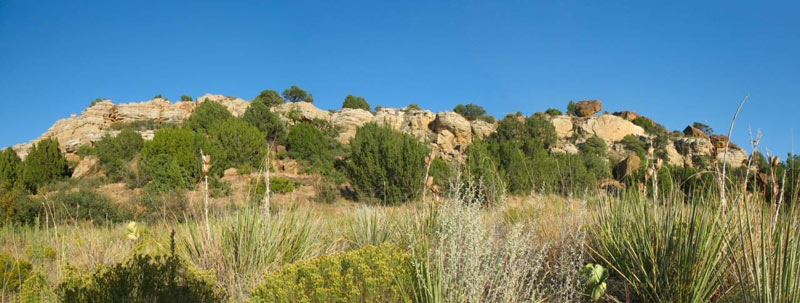

You prepare for months. You gather up thousands of dollars worth of equipment, and drive it, personal goods, and yourself half way across the continent, spending hundreds of dollars on gasoline in the process. You live in a nylon and fiberglass shell for a week, putting up with wind, weather, dust, and critters all the while. What could possibly motivate an arguably sane person to do such a thing you might ask. The answer is a simple two words: Dark Skies!
Okay, maybe three words. Extremely dark skies. That’s the big payoff of going to the Okie-Tex star party, which I attended this year, along with fellow Lowbrows Mark Deprest, Nathan Murphy, who made the trek from Brooklyn, NY, and Robert Wade, who came all the way from Connecticut. One of the nation’s premier annual star parties, it’s held at Camp Billy Joe, a Christian youth camp near Kenton, Oklahoma. It’s at the tip of the Oklahoma panhandle—in fact it’s about as far away from here as you can get and still be in Oklahoma. It’s just south of the Black Mesa, a 4900 foot high plateau that lays claim to being the highest point in Oklahoma.
And the skies there are indeed dark! It’s one of few areas remaining in the continental U.S. that is a true “1” on the Bortle sky darkness scale. On a good night (as most nights there are), most folks can see stars as faint as magnitude seven with the unaided eye. The Milky Way is as bright as you’ve ever seen it, which also makes more obvious the various dark dust lanes and patches that you may not know are even there.
But I’m getting a little ahead of myself. If I let myself I could easily write an entire newsletter’s worth describing the Okie-Tex Star Party experience, but I’ll save that for the presentation Mark and I are planning for the November meeting. Instead, I’ll just describe what I consider the most appealing aspects of the 2007 Okie-Tex Star Party.
The Black Mesa region of Oklahoma is different from southeast Michigan in almost every way. We have close horizons; there the horizons seem to go on forever. Here, it’s cloudy and humid much of the time. There sunny, clear, and dry weather is the rule. Here we have large cities, lots of people, and a lot of light pollution. There there’s more cattle and antelope than there are people—and light pollution is nil. The surrounding bluffs and mesas provide for some fantastic scenery by day, and add interest to the horizon by night.

Yes this is a good thing, because part of the appeal of getting away from it all is, well, getting away from it all. For example the inability of your boss getting ahold of you. While there is no cell phone coverage, the organizers do provide wireless internet coverage so you can still communicate with the rest of the world should you choose to do so.
We saw everything from four-inch long grasshoppers as thick as your thumb to a tarantula to varieties of flowering cactus to a stampede of tumbleweeds! Definitely not things you’ll see around here. And there’s also what I call the “Zoodiac”; but you’ll have to wait for our presentation at the November meeting to find out about that one.
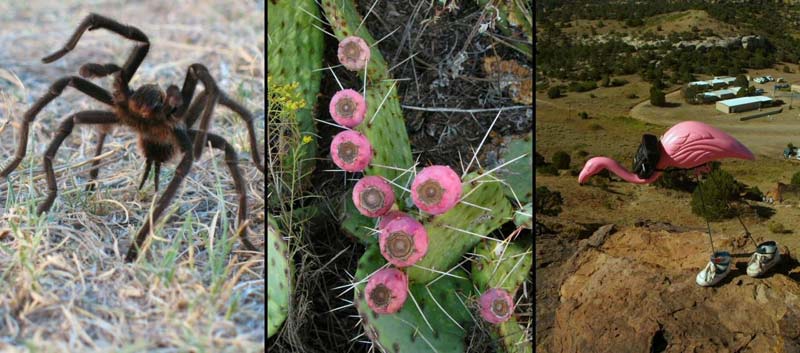
Within an hour’s drive of Camp Billy Joe there’s a volcano (extinct of course) the crater of which you can hike around and into, fossilized dinosaur tracks, a canyon with ancient native American drawings on its walls, the Black Mesa, and a late 19th century hotel where you can get a fantastic meal. Or you can take a short one half mile (or less) walk into Kenton to purchase a few odds and ends or a simple meal at “The Merc,” or visit a little museum with various historical artifacts from the area.

If you want to see large amateur telescopes then this is the star party for you. My 13” and Mark’s 12.5” are almost small in comparison to many we saw there. There were a lot of 20+ inch Dobs, mostly Obsessions, and we even had a 30 inch set up right next to us. There was no shortage of light gathering power.
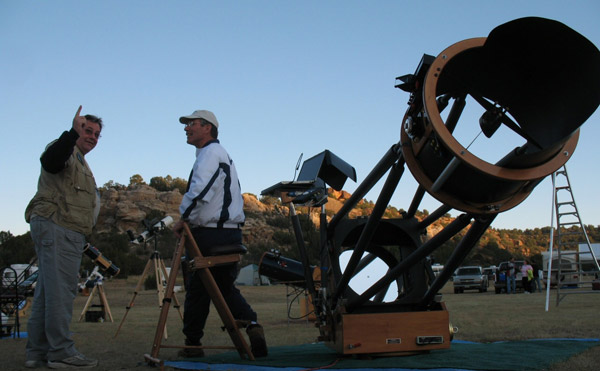
While I’ve met with a lot of nice people at other star parties, I would have to say that by and large the Okie-Tex attendees are some of the friendliest folks you’ll meet anywhere. Everyone seems to have a smile on their face and are willing to talk about their scope or what they were looking at the night before. I’m sure the amazing observing conditions have something to do with that. And of course it wouldn’t have been nearly as good a time without fellow Lowbrow attendees Mark, Nathan, and Robert, barking spiders notwithstanding.

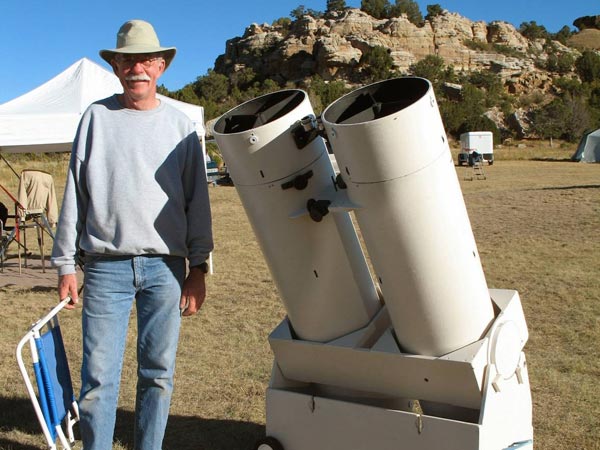
The weather there is so consistent you don’t have to feel pressured into observing everything you can in one night. You can relax, and if you don’t get that object you really want to see one night then you can be reasonably confident that it will be clear the next night so you can afford to wait. It certainly makes for a much more relaxed observing atmosphere. Another plus is the low humidity; we only had a couple nights where there was any dew, but even then it was minimal.
Since all-nighters are commonplace at the Okie-Tex Star Party, quite often you’ll hear your stomach growling at you by midnight. The “Cosmic Café” is open every night from 9:00 until 3:00, so you can recharge with a made-to-order burger, fries, and soda, a bowl of chili, or just a candy bar or a cup of coffee. It makes for a great pick-me-up to keep you going.
Did I mention that the skies are dark? What an understatement. Here’s where I just have to provide a little more detail. The Black Mesa area provides the darkest skies I’ve ever observed under. It is amazing to see objects “the way they were meant to be seen.” Case in point is the great galaxy in Andromeda, M31. We had no scope in Camp Lowbrow with a large enough field of view to fit it all in. This includes Nathan’s 80 mm TMB refractor! The galaxy simply kept on going and going. Another example is B33, the Horsehead Nebula. Besides Mark’s 12.5 inch and my 13 inch, it was even visible in Nathan’s 10-inch Portaball with a UHC filter. You didn’t even need a Hydrogen-Beta filter. Previously the only time we’ve managed to see it was in John Causland’s 61 cm Starmaster with an H-Beta. And so it was with everything else. I had always thought that Patrick Moore was something of a sadist with some of the low surface brightness objects he included in his Caldwell catalog. But after revisiting many of them that I had considered difficult from around here they were rather obvious and almost easy. It was truly amazing—I sometimes found myself just shaking my head almost in disbelief.
And the naked eye view of the sky was nothing short of astounding. In the evening at the end of twilight the zodiacal light was obvious, hugging the ridge in the west, despite the low angle of the ecliptic during October evenings. The early morning sky was even better. The zodiacal light is a huge, obvious wedge of light following the ecliptic from the horizon at least halfway up to the zenith, rivaling the winter Milky Way in brightness. On the other side of the sky, the Gegenshein (German for counter shine) can be seen rising above the western horizon. Meteors were commonplace. More than once I took time out to lie back in my reclining camp chair to simply gather in the grandeur without optical aid.
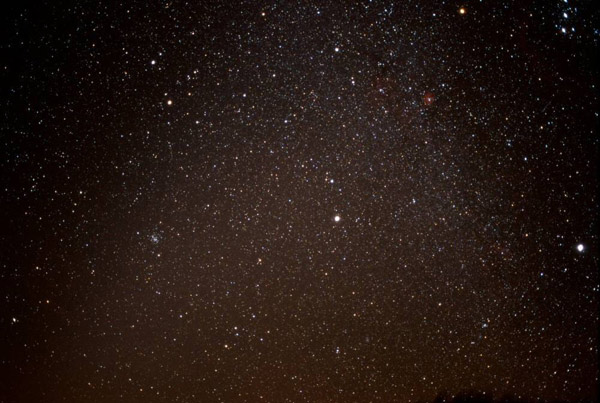
The Bible says “The heavens declare the glory of God.” I don’t know if you believe in a Creator, but there’s no other place else I’ve been that illustrates that more personally to me than at the Okie-Tex Star Party. I can’t wait to go back!
Doug Scobel took all of these photos at the 2007 Okie-Tex Star Party.